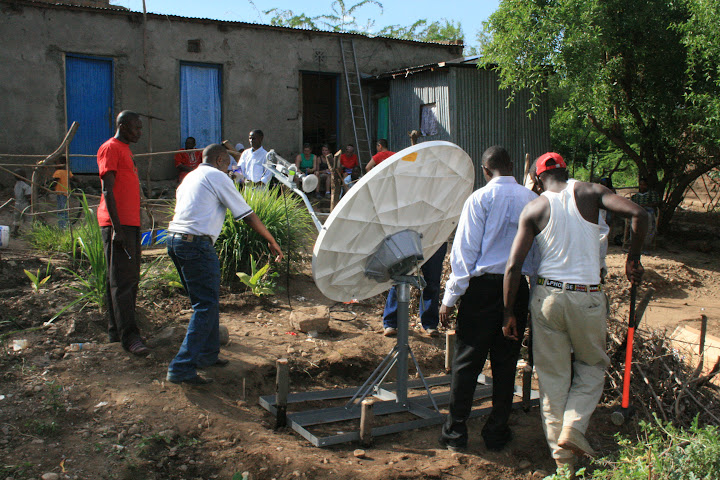I just sat down next to Raphael Marambii, who happens to be the innovations and knowledge management specialist for a small local NGO called ALIN (arid lands information network), at a cyber cafe in Nairobi. As happens in Africa, you get into conversations, and I found out that they have been connecting rural communities via community knowledge centers (sort of rural cybercafes cum libraries / training centers) running solar powered VSAT dishes.

They have deployed a unique prototype solar powered VSAT base station terminal at two of ALIN’s Community knowledge centers, at Marigat and Nguruman, Kenya. The base station is self contained and toughened for remote African rural conditions and requires little expertise to deploy. It’s part of the University of Michigan’s Imagine Africa project.
The question is, “why is this NGO plunking down remote satellite connections in rural Africa?” I asked Raphael just that question, and he tells me that it’s because they strongly believe that information and access to knowledge is what is needed most in these communities. They are trying to get the youth within these rural communities to embrace some of the new social media tools too, like blogging and podcasting.
From what I understand this is a pilot, testing out what happens when a new form of information is freely available within marginalized or disconnected rural communities. Raphael and team have ideas on seeing this become embedded in the community – ranging from helping with eCommerce, to creating new local content, to live video language services available over the connection.
There are two reasons I like this project. First, because it’s being driven by a local NGO, so it has some hopes of making it after the big donors leave. Second, the team is truly trying to think different – they make no bones about how their ways to connect the community to the rest of the world in mutually beneficial ways isn’t “normal”.
The true test however will be found after their 6 months of funding is gone. It costs about 26,000 Shillings ($320) to run one of these each month. Let’s see where this project, and more importantly, the communities are in one year.
December 6, 2008 at 3:58 pm
I know there are VSATs in Pibor and Kapoeta. Also Juba and Yei. Southern Sudan is getting connected.
December 8, 2008 at 7:00 am
hash, if you would introduce us? you know we’re starting that open source grant funded project to look into how communities in rural philipines and india can conceptually pay for a shared resource? thanks
December 9, 2008 at 9:09 am
Kudos for digging out this inspiring news. Just the type of those stories that tell you something about versatility in the midst of challenges that keep us going. And sustainable at that!
December 10, 2008 at 5:05 am
Very interesting project! The sustainability question is huge and we have a research project looking at 10 wireless networks (some VSAT, some not – some telecentres, some not), their business plan and what is necessary for sustainability in rural African communities. thanks for sharing. K
December 10, 2008 at 10:34 am
Outstanding! We too are working on “somewhat” similar efforts in Kenya, the Congo, South Africa, the Philippines and rural India. The different twist we add is bringing “telemedicine” and medical educational resources in via the satellite connection. This allows a rural clinic to be connected to metro hospitals and specialists within their own country. Additionally, we hve a global network of resources we can also lend to the mix if needed.
The same systems also employ a mix of disease migration monitoring tools, disaster management databses, early warning systems (UNHCR has been crying out for this technology in Darfur) and patient databases. The satellite equipped clinics we deploy are housed in 20′ cargo containers, easily trucked to the most remote regions. A network of such Doc-in-a-Box clinics can be rapidly deployed in a disaster or humanitarian crisis region.
I will be running down some of the groups mentioned here to discuss some win/win synergy collaborations. I am very interested in what they have developed egarding a ruggedized VSAT deployment and would like to consider testing it with our clinics.
Please feel free to contact me with any questions, concerns or suggestions any of you may have. See http://www.disasterlogistics.org for more info on our efforts.
Randy – rrobrson@disasterlogistics.org
March 10, 2009 at 3:43 am
its interesting news as am a volunteer in the center mentioned and have been managing the center and helped in running the vsat system. I have lots of experiences gained from running this center and how the communities are using internet and the changes that have occured to them.
I even started blogging right from the village.
I welcome any questions
June 18, 2009 at 6:28 am
caspindia is an NGO please informe us in detail